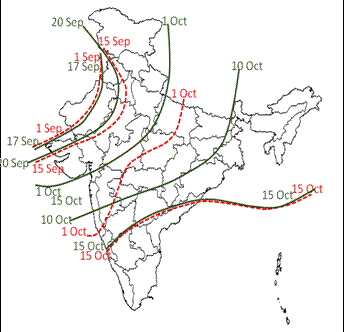
The India Meteorological Department (IMD) on April 15, 2020 announced that it expects monsoon rainfall to be normal this year. “Southwest monsoon seasonal (June to September) rainfall over the country as a whole is likely to be normal (96-104%),” the IMD said in its first stage Long Range Forecast (LRF) for monsoons.
Addressing a press conference through video link, Secretary of Ministry of Earth Sciences Dr. M. Rajeevan released the IMD’s Long Range Forecast for the 2020 Southwest Monsoon Season Rainfall. Director General of IMD, Dr. M. Mohapatra was also present.
DR. Rajeevan said that quantitatively, the monsoon seasonal (June to September) rainfall is likely to be 100% of the Long Period Average (LPA) with a model error of 5%. The LPA of the season rainfall over the country as a whole for the period 1961-2010 is 88 cm.
What is LPA: The LPA (Long Period Average) of the monsoon season over the country is 89 cm, calculated for the period 1951-2000. This is the average rainfall recorded during the months from June to September, calculated during the 50-year period.
He said, IMD will issue the updated forecasts in the last week of May/first week of June 2020 as a part of the second stage forecast.
Dr. Rajeevan pointed out that “ Neutral El Nino Southern Oscillation (ENSO) conditions are prevailing over the Pacific Ocean and Neutral Indian Ocean Dipole (IOD) conditions are prevailing over the Indian Ocean. Some climate model forecasts indicate these conditions are likely to persist during the ensuing monsoon season”.
What is ENSO: The El Niño-Southern Oscillation (ENSO) is a recurring climate pattern involving changes in the temperature of waters in the central and eastern tropical Pacific Ocean. This oscillating warming and cooling pattern, referred to as the ENSO cycle, directly affects rainfall distribution in the tropics.
What is Indian Ocean Dipole: The Indian Ocean Dipole refers to the difference in sea-surface temperatures in opposite parts (Eastern and Western) of the Indian Ocean.
Dr. Rajeevan said that La Nina, or cooler-than-usual sea surface temperatures in the east-central Pacific Ocean, is typically associated with better monsoon rains and colder winters in India while El Nino is associated with below-normal rainfall in the country.
The southwest monsoon season, that replenishes the country’s farm-dependent economy, first hits the southern tip of Kerala usually in the first week of June and retreats from Rajasthan by September.
Onset on June 1: Monsoons are expected to hit Kerala’s Thiruvananthapuram on June 1. In states like Maharashtra, Gujarat, Madhya Pradesh, Chattisgarh, Telegana, Andhra Pradesh, Odisha, Jharkhand, Bihar and parts of Uttar Pradesh, monsoon will be delayed by 3-7 days compared to the existing normal dates.
However, over extreme northwest India, the monsoon arrives now little earlier, on 8th July compared to the existing date of 15th July.
Monsoons are expected to withdraw in south India on October 15.

